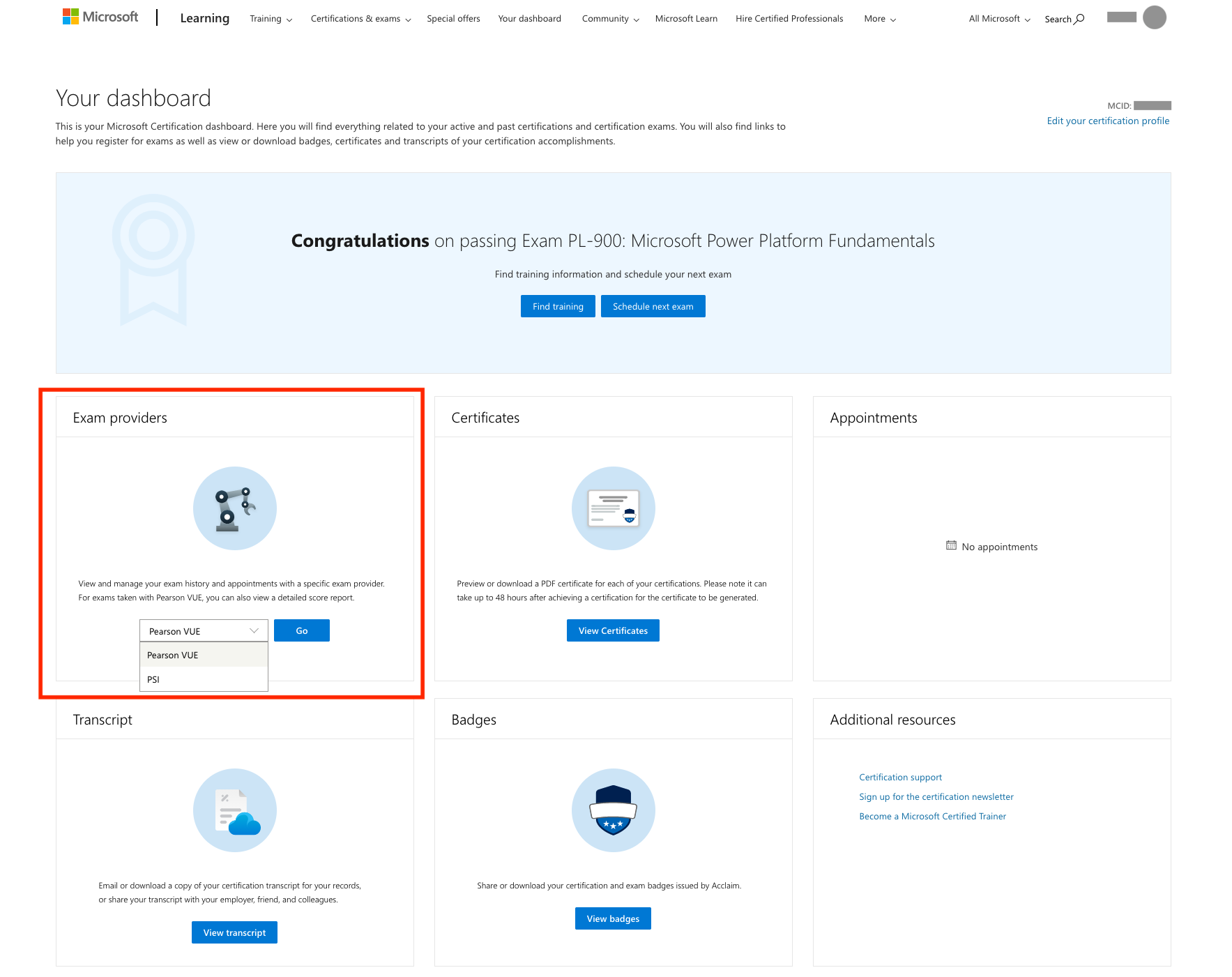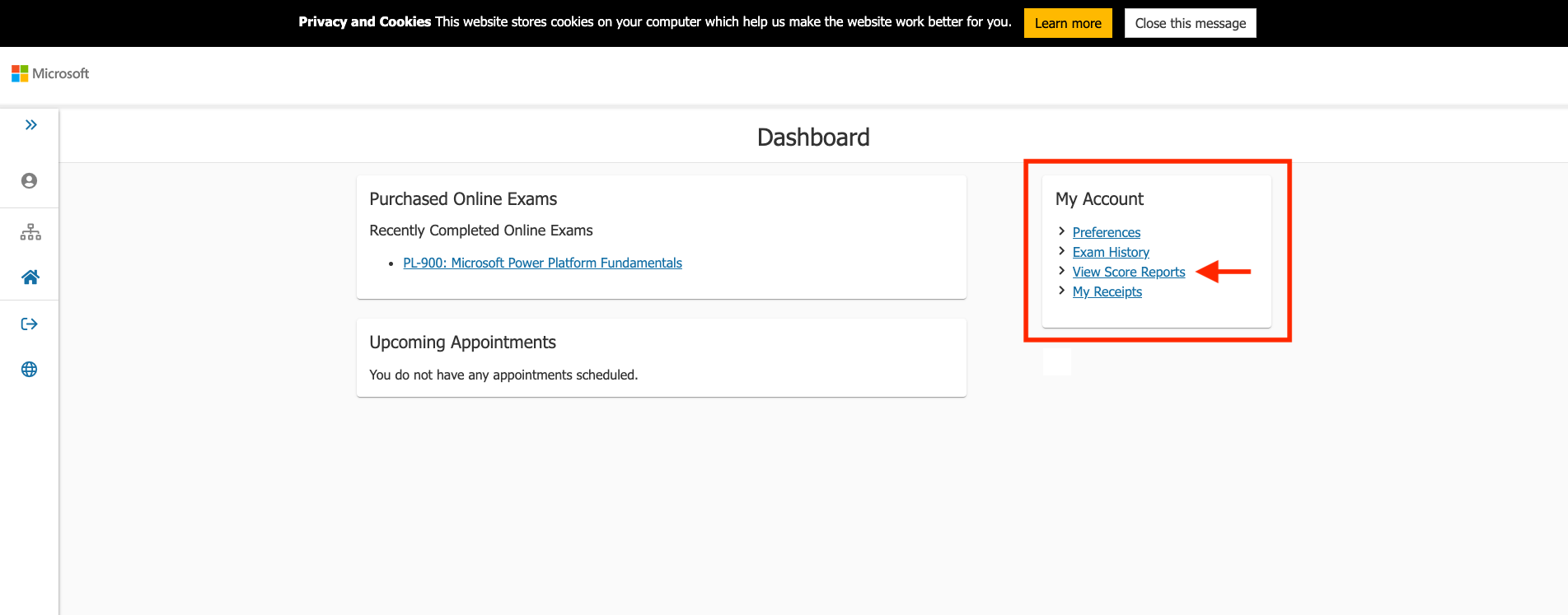Microsoft Exam scoring and score reports
When to expect your score
For most exams, you will receive your pass or fail result within a few minutes of completing your exam. You’ll also receive a report with your exam score and feedback on your performance in the skill areas measured. Exams with labs may take longer to score, and you may have to wait about 30 minutes before receiving your score report. The exam delivery provider will forward your score to Microsoft within 24 hours.
If you took a beta exam, you will not receive a pass or fail result on the day you take the exam. You will receive your score after the exam completes the beta process and goes live. To learn more visit: Beta exams.
How to access your score report
For exams taken with PSI, your score report was sent to the contact email listed on your certification profile and cannot be accessed through your certification dashboard. Score reports are available online for exams taken with Pearson VUE. To access your score report:
- Go to the Certification Dashboard.
- In the “exam providers” section, select “Pearson VUE” from the dropdown, then select “Go”.

- You will be redirected to the Pearson VUE dashboard. In the “My Account” section, select “View Score Reports”.

- Locate the exam you wish to view the score report for, then select the “View” button.

How exams are scored
- Some questions are worth one point, others are worth more than one point. If a question is worth more than one point, this information will be provided in the question. When answering these questions, you will receive one point for each correctly answered component, so you can earn all, some, or none of the points possible for that question.
- There is no penalty for guessing. If you choose an incorrect answer, you simply do not earn the point for that item or part of the item. No points are deducted for incorrect answers.
- Some questions on the exam may not be included in the calculation of your score. To gather data to update and improve the quality of each exam, we present new questions to candidates without counting the results toward their score. However, as soon as we have the necessary data to evaluate the quality of the question, items that meet Microsoft’s psychometric standards will be scored. Microsoft will not inform candidates which questions are unscored; as a result, you should answer every question as if it will be scored.
- Microsoft continues to introduce new and innovative question types that may require different approaches to scoring. Microsoft will indicate if a question is scored differently in the text of the question.
Scores needed to pass exams
- Technical exams: All technical exam scores are reported on a scale of 1 to 1,000 and are scaled such that the passing score is 700. Any score of 700 or greater is a “pass.” Any score below 700 is a “fail.” The actual number of items you need to answer correctly to pass is determined by a group of subject matter experts in conjunction with the Microsoft psychometrician during the development and maintenance of the exam. The passing score is based on the knowledge and skills needed to demonstrate competence in the skill domain and the difficulty of the questions that a candidate answers when taking the exam.
- Microsoft Office exams: All Microsoft Office exam scores are reported on a scale of 1 to 1,000. The passing score varies from exam to exam and is provided on the score report. The actual cut score percentage is determined by a group of subject matter experts using a process like that used to set the cut score for Microsoft’s technical exams.
What to do if you fail an exam
If you fail a certification exam, you can retake it. There is a waiting period between retakes in order to maintain the integrity of the exam. When you fail for the first time, you must wait 24 hours between retakes. For subsequent retakes, the amount of time depends on the type of certification exam. For full details, visit: Exam retake policy.
Your score report will indicate the content areas that are strengths or weaknesses. Prioritize the skills that you should practice by focusing on the content areas where your exam performance was the weakest and in the content areas that have the highest percentage of questions. Additionally, you may want to review the resources provided on the exam details page. Microsoft does not share information about specific questions that were not answered correctly.
When you are ready to retake the exam, schedule an appointment as you normally would. You must pay for each exam you retake and follow the exam retake policy.
Understand an exam score report
The score report provides:
- A numeric score for overall exam performance.
- Pass/fail status.
- A bar chart showing performance on each skill area assessed on the exam.
- Detail on how to interpret your results.
The bar chart shows your performance on each section, or skill area, assessed on the exam. On the left side of the chart, each section of the exam is listed along with its percentage of the exam. The length of the bar will tell you whether that section was a strength or a weakness for you. Shorter bars indicate weakness, longer bars show strength.
This section of the score report is intended to help you identify your areas of strength and weakness in the skill domains that were measured on the exam. It can’t be used to calculate the number of questions answered correctly in that section or on the exam, and the bars cannot be combined to determine the percent of questions that you answered correctly on the exam.
Why Microsoft reports scaled scores
Microsoft reports scaled scores so that candidates who have to retake a certification exam can determine if their performance is improving. The actual cut score (the number of points you need to pass) is based on input from a group of subject matter experts who review the difficulty of the questions in relation to the expected skills of the target audience. As a result, the number of points that you need to pass varies depending on the difficulty of the questions delivered when you take the exam; this ensures that regardless of the difficulty of questions you see, the evaluation of skills is fair. If you see a more difficult set of questions during one administration, the number of points needed to pass is less than if you see an easier set of questions. As a result, providing a simple percent correct wouldn’t provide useful information to someone who had to take the exam multiple times and saw different combinations of questions with different levels of difficulty.
Here’s an example of why scaled scores are a better indicator of how your performance is improving (or not) from one exam attempt to another. Imagine that the first time you take an exam, you see a set of easy items; unfortunately, you fail with a scaled score of 600, which is equivalent to a score of 65% correct. The next time you take the exam, you see a set of more difficult items. This time you pass the exam with a scaled score of 750, which is equivalent to answering 50% of the questions correctly. If we provided the percent you answered correctly, you would think your performance had gotten worse, not better. But it is, in fact, better because you answered a higher percentage of more difficult questions correctly than you did the first time.
Scaled scores simplify your ability to evaluate improvements in your performance over time. This is a standard practice across the certification and licensure industry.
Frequently asked questions about exam scoring and score reports
I received the same score each time I took the same exam. Is there something wrong?
No. Receiving the same score on multiple attempts does not indicate that there is an error in how your score was determined. It is not uncommon for candidates to obtain similar or identical scores on multiple attempts of an exam. This consistent result demonstrates the reliability of the exam in evaluating skills in this content domain. If this happens on multiple attempts, you may want to reconsider how you’re preparing for the exam. Find other opportunities to learn and practice the skills measured by the exam before taking it again.
I scored zero in one of the sections. How is this possible?
The number of questions that measure each skill area is determined through the blueprinting process; sections of the exam measuring critical and/or more frequently performed skills will contain more questions than those that assess less important or less frequently performed skills. Given that the number of questions varies based on the criticality of skills measured, it is entirely possible for a candidate to answer all questions incorrectly in a section that has a small number of questions.
I experienced significant delays between some of the questions. Was my response recorded? Was it scored correctly?
A delay between questions does not impact the responses, scoring, or the time remaining to finish the exam. You should expect to experience a delay of up to a minute while your next question loads. The exam delivery provider’s software is designed to accommodate this. Your answers are recorded, and the exam will be scored correctly regardless of delays between questions.
Does the score report show a numerical score for each section?
No. The score reports provide an overall numerical score to reflect pass/fail status only. We provide section level information as a bar chart because this is more reliable way to understand your strengths and weaknesses.
The bars on the score chart show that I scored more than 70 percent. Why didn’t I pass the exam?
Each section of the exam contains a different number of questions. Therefore, combining the results across individual exam sections will not reflect your final exam result. In other words, there is no one-to-one relationship between the length of the bars and your pass/fail status.
Another misconception is that you must answer 70 percent of the questions correctly to pass the exam because the passing score is 700. However, this is a scaled score. The actual percentage of questions that you must answer correctly varies from exam to exam and may be more or less than 70 percent. This depends on the input provided by the subject matter experts who help us set the passing score during exam development and the difficulty of the questions that you saw when you took the exam.
If you never took a Microsoft Certification, have a look at Value of a Certification!
Original reference https://docs.microsoft.com/en-us/learn/certifications/exam-scoring-reports